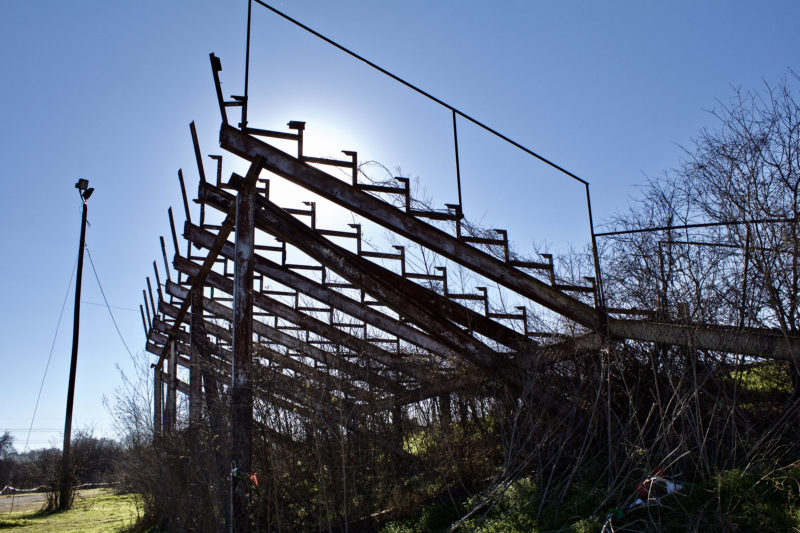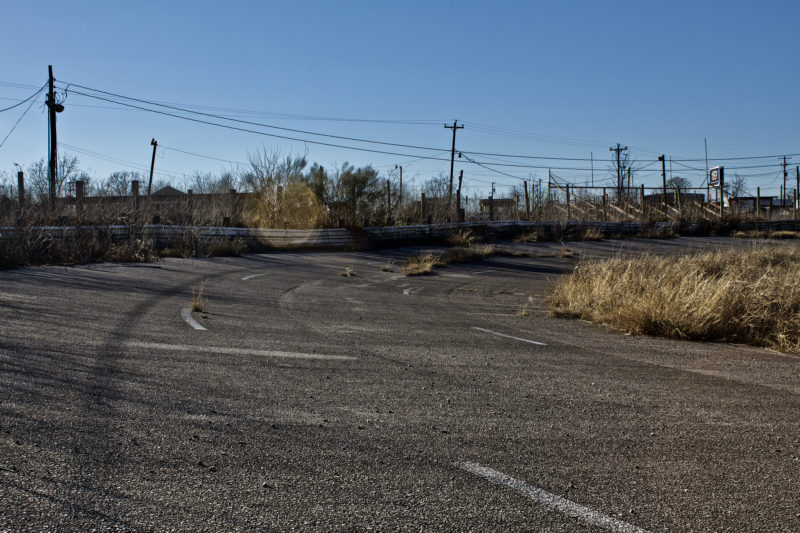Long After Its Final Flag, Longhorn Speedway Remains a Champion in Racing Lore
By Alanis King
Photography By Alanis King
Reporting Texas

A set of stands on the former backstretch at Longhorn Speedway, now rusted and littered with leftover trash from the weekend flew market. Alanis King/Reporting Texas
Other than a weekend flea market, life is quiet at the corner of U.S. 183 and FM 812 in Southeast Austin. There’s a VFW post, a small Circle K gas station and scattered Mexican restaurants. Dirt roads cut through high grass.
But if you look down the gravel road leading to that flea market and strain your eyes just enough, faint white lines will come into view — lines that once marked the lanes on a racetrack.
That track is the old quarter-mile Longhorn Speedway, a former local short track which resides, defunct and wilting, less than 5 miles from Circuit of the Americas — the 3.427-mile track that hosted nearly 270,000 spectators over its Formula One weekend last fall.
Over the years, Longhorn has joined hundreds of other racetracks across the U.S. and become what’s known as a “ghost track” — a racing facility that, for whatever reason, eventually closed. The phenomenon stretches to tracks that once hosted NASCAR’s top divisions, such as North Carolina’s North Wilkesboro Speedway that operated from 1949 to 1996 and hosted 93 races in what’s now known as the Monster Energy NASCAR Cup Series.
Longhorn closed in 1998 or ’99, depending on whom you ask. It originally opened in 1960 as Austin Speed-O-Rama, but went through multiple name changes and leaseholders during its nearly 40 years in operation.

The first and second turns at Longhorn Speedway, which once held races every Friday night until it closed in the late 1990s. Alanis King/Reporting Texas
The father-son pair of A. B. and Louis Wusterhausen opened the track, owning and managing for eight years before the Austin American-Statesman reported that a local racing group had taken over the lease. A. B. Wusterhausen died before the handover in 1968, and the racetrack became known as Capital Speedway under its new owners.
That group, led by a drag racer by the name of Jim Tibbitts, promised a prize purse of at least $1,200 per race once its reign began — “much more than any regular race [had] ever payed in Central Texas” at the time, according to the Statesman.
That reign didn’t last long, and the track went back to its former name — without the hyphens. Business partners Jerry Green and Charles Hester took over the track in 1971, promising “exciting, fast-moving” shows and kids’ nights with free rides in the figure-eight races.
It was called Longhorn Speedway when it eventually closed, with grandstands left to rust and asphalt to crack even more under passive ownership by an Austin real estate group.
The main grandstands at Longhorn used to face away from the highway, the spectators a sea of colored dots among a small press box and a flag stand on the start-finish line. In 1966, a family of three could get into the show for $3.50 total.
For decades, drivers used to line up for photos in front of the grandstands before firing up their engines. Male racers sported high-waisted, light-wash jeans and thick mustaches while standing next to sash-wearing trophy girls with voluminous, roller-curled hair.
Drivers would see three more sets of grandstands as they battled around the track, most of their cars wearing the dents of weekends past and giving off the rough, unpolished vibe that short-track racing often does.
The drivers weren’t so polished either. Before the first race under the new name of Capital Speedway, Chief Swinford told the Statesman his 1955 Chevrolet was “handling like a washtub with a fat woman sitting on it.” Another driver, Homer Newland, muttered “unprintable words” about driving 3,600 miles from Detroit to Longhorn.
In Longhorn’s four decades, there was at least one Confederate flag on a car: that of Tom Fowler, who advertised being “the only hell mama ever raised” on his rear quarter panel. Some paint schemes came from a spray can. It was a local operation, and that was part of the charm.
But it was more than a local operation in many ways. Future racing icons might once have raced at Longhorn. Those who frequented the track can’t remember whether future Cup Series champion Terry Labonte or Indy car legend A.J. Foyt raced out there.
Labonte did race at other local short tracks across Texas, and even won the first local Late Model track championship at the nearby San Antonio Speedway in 1977. Small tracks such as Longhorn were the beginning of the pipeline for oval racers like Labonte nationwide.
Each time a local track closes, entry into that pipeline becomes more choked.
Records on past winners, track record holders and the like are scarce, and drivers who raced out there almost impossible to track down. But once you find someone, the memories all come to the same conclusion.
“It was a really good speedway,” said Denise Beier Zuniga, who regularly attended shows at Longhorn as a child after moving from Pennsylvania in the late 1960s. “It could fit a lot of people; it was always crowded. The atmosphere was always charged and fun.”
In its day, former Longhorn Speedway PA announcer Neil Upchurch said, the track’s premiere Late Model events — one of the most expensive and exclusive divisions in short-track racing — would pull around two dozen cars on Friday nights in the late 1980s and into the ‘90s.
“When we had that many cars, we had to limit the starting field to 18 or 20 for manual-scoring reasons,” said Upchurch, referring to the days when positions on each lap had to be checked off by hand. “For that reason, qualifications actually fulfilled their name. You had to qualify to be in the feature race, because we couldn’t put all of the cars that were there on the track at once.”
Upchurch said the Late Model drivers at Longhorn were “the best in Texas,” recalling those such as Jimmy “Fireball” Finger and Freddy Fryar as some of the most popular behind the wheel.
Zuniga remembered Upchurch’s voice as if it had called a race yesterday — a powder-puff race in which women drove their husbands’ cars came to mind.
“Sometimes it would be hilarious, because the husbands would hide in the car, since some of the women didn’t know how to drive stick,” Zuniga said. “They would do the gears for them, and I remember Neil Upchurch saying one time, ‘So-and-so, you need to get out of that car and let your wife drive, even if it is in first gear!’”
But it wasn’t all about the atmosphere or the memories made at Longhorn. David Umscheid, whom both Zuniga and Upchurch remembered as one of the best drivers to race there, said Longhorn was “the best racing track” that he ran on.
“It was a place where if you learned how to pass there, other racetracks were pretty easy,” said Umscheid, who raced at Longhorn from 1978 through around 1990. “Longhorn was just smaller. Things happened more quickly. You pretty much had to be on your game the whole race.”
The pits were outside of the oval at Longhorn. They’re now a gravel parking lot for a food truck.
As the 1990s came to a close, the real problem set in. Less than 30 minutes away, construction began on a new asphalt short track in Kyle. The track opened as Thunderhill Raceway for the 1998 season.
With that, the demise of Longhorn Speedway became final. The leaseholders gave up the track.
“It was strictly a business decision,” Upchurch said. “The market [in Austin] is not big enough for two short tracks.”
Zuniga visited Thunderhill after Longhorn closed, and said things were different. The crowd wasn’t as big; the atmosphere wasn’t the same.
“It didn’t feel as homey as [the racing] once did,” Zuniga said. “There were still the same drivers, Bobby Joe New, Larry Darity and all of them who used to race down at Speed-O-Rama and in San Antonio, but the feel was just totally different.”
Within about a decade of Zuniga’s visit, the feel at Central Texas Speedway changed yet again. With almost no notice, leaseholder Tim Self, whose NASCAR-bound son raced out at the track for much of his short-tracking days, decided not to renew his claim on the racetrack following the 2016 season. It closed immediately.
“One by one, every track has faded to black,” Upchurch said. “The [decline] of racing in Texas was, in some cases, so slow that it was hardly noticeable. The reduction and the closure of [asphalt] tracks has been a very slow cancer to creep along and eventually, we have one go down permanently.”
Eventually, all of the asphalt short tracks Upchurch frequented closed. The half-mile Meyer Speedway in Houston, which hosted a 1971 Cup Series race in which Bobby Allison and Richard Petty started on the front row in front of 9,000 spectators, went down in the late 1970s. San Antonio Speedway opened in 1977, but closed its gates a few decades later.
That track “came up a couple of times like a drowning person coming up for a breath of air,” Upchurch said. “And then, it finally just went down and stayed down.”
In response to the eventual closures that loomed over those racetracks, Upchurch said, there are “certain sports, or attractions, that eventually just wear out.”
But the memories of Longhorn didn’t wear out.
“It breaks my heart,” Umscheid said. “That’s the first racetrack I came to watch races. Both of my kids turned their first laps there. It’s just sad.”
Zuniga passes it every once in a while, remembering the days of demolition derbies, stunt shows and Friday-night racing features.
She’s sure that someday, the old place will be bulldozed and ready for new construction.
“It’s like losing and old friend,” Zuniga said. “It makes me sad.”
Said Upchuch: “I could see the demise of racing in the Southwest even happening way back then. With that demise, I was not going to invest in a property because of a track, because the tracks may fail. And sure enough, all of them have.”